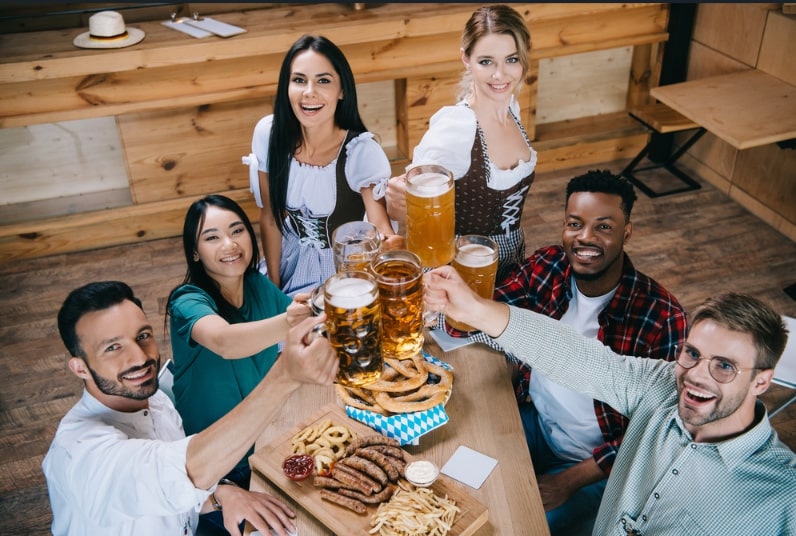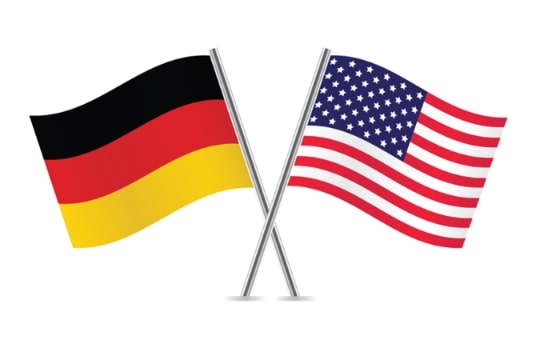Introduction: In this article – the first of a two-part series – Katie Rebecca Garner describes German American naming patterns, to help with your research on German American ancestors. Katie specializes in U.S. research for family history, enjoys writing and researching, and is developing curricula for teaching children genealogy.
You might think you’re eating something very American as you bite into a hot dog topped with sauerkraut, but this, among other “American” foods, actually originated in Germany. Other foods originating in Germany include bratwurst, pretzels, pickled vegetables, and breads such as sourdough, rye, and pumpernickel.

Photo credit: https://depositphotos.com/home.html
The Germans who came to America brought more than their food with them. They brought their language and culture as well. If you have German American ancestors, knowing their practices can help you understand what you find when you research them. The first article in this two-part series will discuss German American naming patterns. The second article will focus on history, language, and religion.
Given Names
It is most helpful to understand naming patterns when doing genealogical research. A common naming pattern in many European cultures, including Germany, is to name the first three sons after the grandfathers and the father and the first three daughters after the grandmothers and the mother. In some parts of Germany, fourth and subsequent sons or daughters would be named after great-grandparents and great-great-grandparents. In other parts, fourth and subsequent sons and daughters would be named after aunts and uncles.
Some families would reuse a name when a sibling died. In some German villages, surviving siblings would bear the same name. Sometimes, a name would be popular because a prominent individual in the community was frequently a sponsor at baptisms. Catholics might have named kids after obscure saints.
Germans and German Americans also used the practice of using forenames or “prefixes” (first names) and rufnames or “call names” (middle names) and went by the rufname. The forenames commonly used for boys were Johann or Hans; the forenames commonly used for girls were Anna or Maria. A family usually was consistent with the forenames they used for their children. The baptismal record would contain the full name, and other records would only contain the rufname. The exception to this was to distinguish between different people with the same name living in the same town.
Be skeptical of English translations of German records because some translated German names to a common (but not necessarily correct) English name, for example translating both Johann and Hans to John.
Toward the middle of the nineteenth century in America, the mother’s maiden name began being used as the middle name, and the forename-call name practice was dropped. Some children were baptized with their mother’s maiden name, while others adopted this practice later in life.
Nicknames
Another interesting thing to note about German names is their nickname practices. Instead of using a given name’s first syllable(s) as the nickname, they’d use the last. For example, Hans is short for Johann, and Stine is short for Christine. My great-grandmother, Geraldine, went by Deeney. Some of my German heritage comes through her.
Additionally, Germans would use nicknames in formal records. This affects how you may search for your ancestors. Some search engine algorithms are programmed to catch common nicknames, but not all search engines are that smart. A nickname having a different first letter than the original name means it falls under a different Soundex code. This means you may need to perform separate searches for your ancestor’s full name and nickname.
Surnames
The other side of the naming coin is surnames. Surnames were adopted in the 14th to 16th centuries based on occupations, places, characteristics, patronyms, and farm owners. Occupational surnames usually end in -er, -mann, -macher, or -hauer. My surname, Garner, is a German occupational surname. Geographic surnames can be either general or specific. Bachmann and Bergman are examples of general geographic surnames; Marburger and Schweitzer are examples of specific ones. Examples of characteristic surnames include Lang, Weiss, Klein, Gross, Nase, and Teufel. There are many others, and listing too many would make this article too long.
Patrionymic Surnames
Patrionimics followed the Scandinavian style (based on the father’s first name) and were unfixed until the mid-nineteenth century. Surnames based on the farm owner – hofnames – changed every time the farm changed ownership. These styles of surnames were common in different parts of Germany.
Have you seen any of these naming patterns in your ancestors? If so, stay tuned for the second article in this series to learn more about your German American ancestors.
Explore over 330 years of newspapers and historical records in GenealogyBank. Discover your family story! Start a 7-Day Free Trial
Note on the header image: German and American flags. Credit: https://depositphotos.com/home.html
Related Articles:
- Common German Last Names & Their Meanings
- Common German Holiday Traditions
- German Wedding Traditions and Customs
- Don’t Speak German? You Can Still Use German-Language Newspapers for Genealogy
Resources:
- https://www.familysearch.org/rootstech/session/german-research-for-the-everyday-american
- https://familytreewebinars.com/webinar/the-voyages-of-our-german-immigrants/?search=german
- https://familytreewebinars.com/webinar/get-with-the-times-german-newspaper-research/?search=german
- https://familytreewebinars.com/webinar/the-palatine-immigrants-tracing-and-locating-18th-century-german-immigrants-online/?search=german
- https://familytreewebinars.com/webinar/searching-for-a-pennsylvania-german-ancestor/?sortby=newest&search=german
- https://familytreewebinars.com/webinar/is-this-the-end-taking-your-german-brick-walls-down-piece-by-piece/?sortby=newest&search=german
- https://familytreewebinars.com/webinar/german-names-and-naming-patterns/
- https://likewolf.com/german-american-food-tradition-of-good-taste
- Buiter, A. S. (2020). Tracing Immigrants through the Port of New York: Early National Period to 1924. New York Genealogical and Biographical Society.
- Freilich, K. H. (2016). NGS Research in the States Series: Pennsylvania (B. V. Little, Ed.; 3rd ed.). National Genealogical Society.
- DeGrazia, L. M. (2013). NGS Research in the States Series: Research in New York City, Long Island, and Westchester County (B. V. Little, Ed.). National Genealogical Society.
- Shawker, P. O. (2008). NGS Research in the States Series: Maryland (K. Freilich & A. C. Fleming, Eds.). National Genealogical Society.
- Clint, F. (1976). Pennsylvania Area Key (2nd ed.). The Everton Publishers, Inc.
